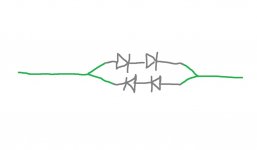the same IC didn't produce any noise from my previous dac (benchmark dac2)
Much lower source resistance in the case of your DAC2.
Dave.
they are brilliant, allows listening to AM radio without the need for a tunerWhat genius came up with the idea of unshielded interconnects?
I use both nanodigi and 4x10 HD never had any noise problems . Sources are only digital , PC and CD player.One thing I would like is positive gain on nanodigi.My amps are Arcam delta 290 bass, Cambridge audio 740a mids and Dynaudio DT-307A tweeters.The nano controls the system volume on the 4x 10HD
Volume is disabled. Muito speakers are diy 90db
Volume is disabled. Muito speakers are diy 90db
Last edited:
I didn't read the whole thread, but I thought I would just chime in what what I was able to do to stop the noise I was getting from my miniDSP among possible other devices. Primarily I was hearing it through my focal tweeters.
First my amplification requires me to use AC wall sockets that are on different breakers or said breakers need to be reset often. So, I did have a house ground loop to begin with. I spread the amperage between 2 different outlets on 2 different circuits and I took a power strip apart on one of the circuits and added large diodes 2 in series in each direction on a split ground to the AC circuit. I then took a 18 gauge solid core copper wire and grounded the chassis of every component that has an unbalanced or HDMI interconnection. The theory being the path of least resistance will no longer be the HDMI or RCA connections. Finally I removed the coaxial connection from my TV in the room with my AV gear, I primarily watch digital formats in that room anyway.
Not sure which of these had the most improvement because I did them all in one swoop, but now I don't hear a peep out of any devices or my focal tweeters even with amps cranked up and no output.
First my amplification requires me to use AC wall sockets that are on different breakers or said breakers need to be reset often. So, I did have a house ground loop to begin with. I spread the amperage between 2 different outlets on 2 different circuits and I took a power strip apart on one of the circuits and added large diodes 2 in series in each direction on a split ground to the AC circuit. I then took a 18 gauge solid core copper wire and grounded the chassis of every component that has an unbalanced or HDMI interconnection. The theory being the path of least resistance will no longer be the HDMI or RCA connections. Finally I removed the coaxial connection from my TV in the room with my AV gear, I primarily watch digital formats in that room anyway.
Not sure which of these had the most improvement because I did them all in one swoop, but now I don't hear a peep out of any devices or my focal tweeters even with amps cranked up and no output.
I took a power strip apart on one of the circuits and added large diodes 2 in series in each direction on a split ground to the AC circuit.
What is the idea behind the series diodes?
What is the idea behind the series diodes?
Rectify the audio signal...
Sorry i couldn't resist

What is the idea behind the series diodes?
The principal is as follows;
Ground loop noise is from very small amounts of voltage present between the 2 ground locations, in this case 2 different AC wall circuits. Typically this is on the order of 0.05-0.20 volts or so. The diodes need 0.60-0.90 volts to pass voltage forward, and completely block voltage in the opposite direction. So, a couple in series requires 1.50-2.00V (plenty of headroom) roughly to pass this stray voltage by putting the diodes in a forwarding state. So, all stray ground loop voltage is blocked in each direction, unless the voltage exceeds the forward voltage needed ~2.0V. So, theoretically, you block all the stray voltage, but still have a pathway to ground if a real failure happens and requires a pathway to ground, this failure will always exceed the 2.0V needed for the diodes to forward the current.
Just make sure the diodes used are at least double your voltage and double your breaker amperage 240V 30A or better in the US is a good safe bet. This way your safety link to ground in the event of a failure will not blow the diode and break the ground circuit. I am not sure how "safe" this is, i'm sure someone somewhere will tell you it is not. I don't care, it's safer than cutting the ground pin like I used to do. People went decades without a ground wiring even existing in homes, My NAD and and Denon receiver don't even have a ground wire in the AC plugs, I have no children at home and it's been decades since I have been drunk enough to pi$$ on one of my amplifiers. I've had this setup for a few years now without issue. My setup uses 4 diodes, 2 on each forwarding direction, make sure you have a forwarding state capable in each direction of the current flow.
Last edited:
One final thought on this. I intentionally used a power strip with a ground fault light for this modification, my intent was that it would be obvious to someone else that this power strip had been modified and was not working "correctly" however, to my surprise, the light stays green and it says the ground is fine and not in fault. Take that for whatever it may or may not mean.
- Status
- This old topic is closed. If you want to reopen this topic, contact a moderator using the "Report Post" button.
